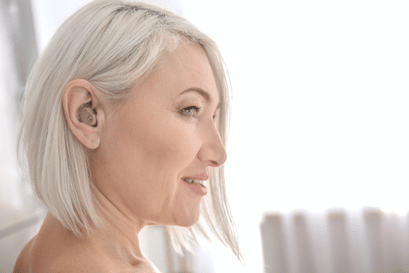There are a variety of reasons as to why people experience hearing loss. So, to properly combat this condition, we offer a variety of options. Our Team offers Bone-Anchored Hearing Aids from Cochlear. These implantable devices could help patients to hear more clearly and make their lives easier.
What is a Bone-Anchored Hearing Aid?
The BAHA system from Cochlear is a bone conduction implant for hearing loss. The Bone-Anchored Hearing Aid is FDA-cleared to help treat hearing loss. The BAHA is a surgically implanted device that uses your natural ability to conduct sound to bypass the damaged part of the ear. This sends sound directly to the inner ear. These medical devices help people with single-sided deafness, mixed hearing loss, or conductive hearing loss. It can also be a viable option for those with Treacher Collins Syndrome, Goldenhar Syndrome, Chronic Ear Infections, Down Syndrome, acoustic neuroma, and middle ear issues. This system has been approved for children as young as 5 and adults of all ages.
BOOK A HEARING AID CHECK TODAY!
Hearing aids remain the most effective way to treat hearing loss, and getting the most out of them requires the expertise of a knowledgeable Doctor of Audiology. Like any other device, hearing aids need ongoing maintenance and calibration to work at their best. Learn more about your hearing aid options and the comprehensive experience you can find here at NYHD.
How Do Bone-Anchored Hearing Aids Work?
The Cochlear BAHA system contains three components: the implant, an abutment or magnetic attachment, and a sound processor. Cochlear offers two different types of BAHA attachment systems to fit each patient’s hearing loss needs.
The BAHA Attract System: a magnetic connection.
This system works with a sound processor that picks up vibrations from the environment. The processor passes the sound vibrations to an attached external magnet. This magnet attracts to the internal magnet. The sound vibrations are transferred through the magnetic attachments to a small titanium implant which is inserted into the bone behind the ear. Through the bone, the sound vibrations are sent to the cochlea (inner ear) where they are converted into electrical pulses. The pulses travel to the brain which perceives the sound.
The BAHA Connect System: an abutment connection.
This system includes a sound processor that picks up vibrations from the environment. The vibrations are transferred through an abutment to a small titanium implant that has been inserted in the bone behind the ear. Then these sound vibrations are sent directly to the cochlea (inner ear) and converted into electrical pulses. These pulses are sent to the brain which perceives the sound.
Types of Bone-Anchored Hearing Aids?
Our team offers three different BAHA sound processor options. These can fit a patient’s degree of hearing loss.
- The Baha 5 Sound Processor
- The Baha 5 Power Sound Processor
- The Baha 5 SuperPower Sound Processor
Candidates for Bone-Anchored Hearing Aids?
Adults and children with hearing loss who do not get benefits from regular hearing aids the bone-anchored hearing aid system can be a life-changing option. To find out how these devices could benefit you, contact the specialists at NYHD to learn more about the BAHA system.
Schedule a Consultation
Our team at New York Hearing Doctors Institute for Hearing & Balance is proud to be part of the Cochlear Provider Network and to collaborate with some of the top otologists/ear surgeons in the country. To learn more about bone-anchored hearing aids and how they could be beneficial, contact our Doctors of Audiology at our New York City Office. To schedule a consultation, call our office at (212) 774-1971 or fill out our online form.




